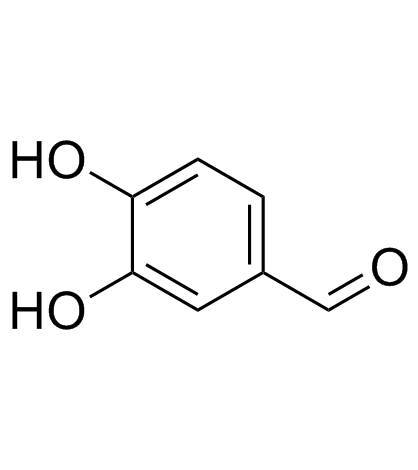3,4-Dihydroxybenzaldehyde

3,4-Dihydroxybenzaldehyde structure
|
Common Name | 3,4-Dihydroxybenzaldehyde | ||
|---|---|---|---|---|
| CAS Number | 139-85-5 | Molecular Weight | 138.12 | |
| Density | 1.4±0.1 g/cm3 | Boiling Point | 295.4±20.0 °C at 760 mmHg | |
| Molecular Formula | C7H6O3 | Melting Point | 150-157 °C(lit.) | |
| MSDS | Chinese USA | Flash Point | 146.7±18.3 °C | |
| Symbol |

GHS07 |
Signal Word | Warning | |
|
Synthesis and accumulation of aromatic aldehydes in an engineered strain of Escherichia coli.
J. Am. Chem. Soc. 136(33) , 11644-54, (2014) Aromatic aldehydes are useful in numerous applications, especially as flavors, fragrances, and pharmaceutical precursors. However, microbial synthesis of aldehydes is hindered by rapid, endogenous, and redundant conversion of aldehydes to their corresponding ... |
|
|
3D-QSAR and molecular docking studies of benzaldehyde thiosemicarbazone, benzaldehyde, benzoic acid, and their derivatives as phenoloxidase inhibitors.
Bioorg. Med. Chem. 15 , 2006-15, (2007) Phenoloxidase (PO), also known as tyrosinase, is a key enzyme in insect development, responsible for catalyzing the hydroxylation of tyrosine into o-diphenols and the oxidation of o-diphenols into o-quinones. Inhibition of PO may provide a basis for novel env... |
|
|
Chromatographic evaluation and QSAR optimization for benzoic acid analogues against carbonic anhydrase III.
J. Enzyme Inhib. Med. Chem. 30 , 420-9, (2015) An HPLC-size exclusion method was developed as an assay method to evaluate the binding of tested compounds with carbonic anhydrase III (CAIII) enzyme. Inhibition of CAIII by a group of benzoic acid analogues was characterized by vacancy (negative) peak intens... |
|
|
[Multi-component of Cibotium baronetz decoction pieces via 1H-NMR spectroscopic analysis].
Zhongguo Zhong Yao Za Zhi 38(3) , 371-5, (2013) 1H-NMR technology was carried out to investigate the chemical difference between 30 batches of Cibotium baronetz decoction pieces and look for new method for quality control of C. baronetz decoction pieces.Six hundreds MHz H-NMR spectroscopy and principle com... |
|
|
[Studies on the chemical constituents of marine sponge Iotrochota sp].
Zhong Yao Cai 33(4) , 545-6, (2010) To study the chemical constituents from the marine sponge Iotrochota sp.The compounds were isolated and purified by various column chromatography methods, and their structure wer identified cholesterol (1), nonadecyl ethers of glycerol (2), p-hydroxybenzaldeh... |
|
|
Melanogenesis inhibitors from the desert plant Anastatica hierochuntica in B16 melanoma cells.
Bioorg. Med. Chem. 18 , 2337-45, (2010) The methanolic extract from the whole plants of Anastatica hierochuntica, an Egyptian herbal medicine, was found to inhibit melanogenesis in theophylline-stimulated murine B16 melanoma 4A5 cells. Among the constituents isolated, anastatin A, silybin A, isosil... |
|
|
White emission magnetic nanoparticles as chemosensors for sensitive colorimetric and ratiometric detection, and degradation of ClO⁻ and SCN⁻ in aqueous solutions based on a logic gate approach.
Nanoscale 7 , 11712-9, (2015) Fluorescent chemosensors for detecting single anions have been largely synthesized. However, the simultaneous detection and degradation of multiple anions remain a major challenge. Herein we report the synthesis of a white emission nanoprobe on the basis of a... |
|
|
Inhibitory effects of hydroxylated cinnamoyl esters on lipid absorption and accumulation.
Bioorg. Med. Chem. 23 , 3788-95, (2015) Obesity is a risk factor associated with several lifestyle-related diseases, for example, diabetes, high blood pressure, hyperlipidemia and cancer. Caffeic acid 2-phenylethyl ester (CAPE, 1), a naturally-occurring compound found in various plants and propolis... |
|
|
Ethnobotanical survey, chemical composition, and antioxidant capacity of methanolic extract of the root bark of Annona cuneata Oliv.
J. Med. Food 14(11) , 1397-402, (2011) The root bark of Annona cuneata Oliv. is traditionally used in the Democratic Republic of Congo to treat several debilitating conditions, such as hernia, female sterility, sexual asthenia, and parasitic infections. However, little is known about the compositi... |
|
|
The theoretical and experimental study on dicalcium phosphate dehydrate loading with protocatechuic aldehyde.
J. Mol. Model. 16(7) , 1187-94, (2010) The aim of this study is to investigate the interaction between dicalcium phosphate dihydrate (CaHPO(4) x 2H(2)O, DCPD) and Protocatechuic aldehyde (C(7)H(6)O(3), Pca), which is the water-soluble constituents of Chinese Medicine, Salvia Miltiorrhiza Bunge (SM... |